Gnidia pinifolia
Gnidia pinifolia L.
Family: Thymelaeaceae
Common names: pine-leaved saffron-bush, needle capesaffron (Eng.), aandbossie, juffertjie-roer-by-die-nag (Afr.).
Introduction
Gnidia pinifolia has showy, conspicuous, white blooms, all-year round, that will infuse your garden with a night scent.
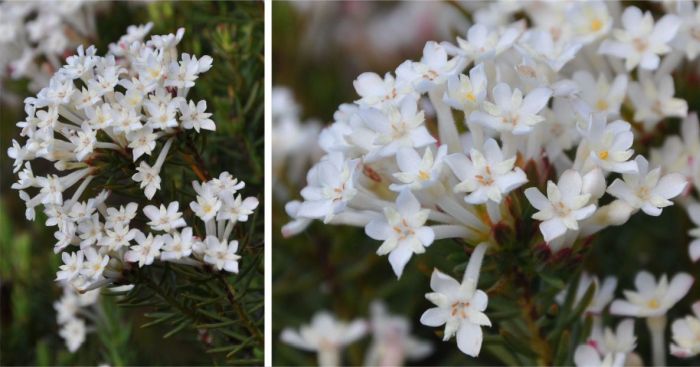
Description
Description
Gnidia pinifolia is a shrub, up to 1 m tall, arising from a woody base, with erect, semi-hardwood stems and smooth to rough bark with lenticels. Branches are rather slender, forked, fastigiate (growing more or less parallel to the main stem), upright and glabrous (hairless), with leaf-scars that are moderately prominent and close to each other. The leaves are small, alternately positioned, acerose (needle-like), narrowly linear-oblong, pungent-acuminate (tapering to a sharp point) ascending, crowded at the branch tips; the involucral leaves are wider, green, the leaf apices acute, becoming brown or reddish.
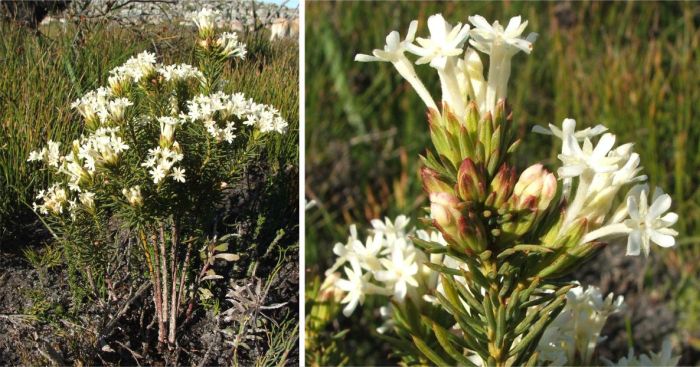
The flowers are in showy clusters of about 10, at the branch tips, pinkish opening to white. The flowers consist of a long calyx tube, the hypanthium, which is villous (densely covered in shaggy hairs), the lower quarter is inflated and triangular when cut in half, the upper part is nearly cylindrical. At the tip of the tube there is a pointed star, made up of 4 calyx lobes that look like petals. The true petals are the 4 smaller, cream coloured lobes on top of the white calyx lobes, they are finger-like, fleshy and densely hairy. The anthers are oblong, obtuse, yellow to orange-brown, one row can be seen at the mouth of the tube and a second row is hidden inside the calyx tube; the ovary is shortly stipitate (has a short stalk) and glabrous; the style is nearly as long as the calyx-tube; and the stigma is capitate (ends in a compact head). The flowers are often pink in bud, the tubes are white flushed with pink or randomly stained pink, the petals inside the star have an off-white to yellowish colour, the anthers are yellow. The bases of the tubes often appear deep maroon, but this is caused by the involucral leaves that cover the base of the tube. Overall, they give an attractive soft colour effect. Flowering can occur at any time of the year.
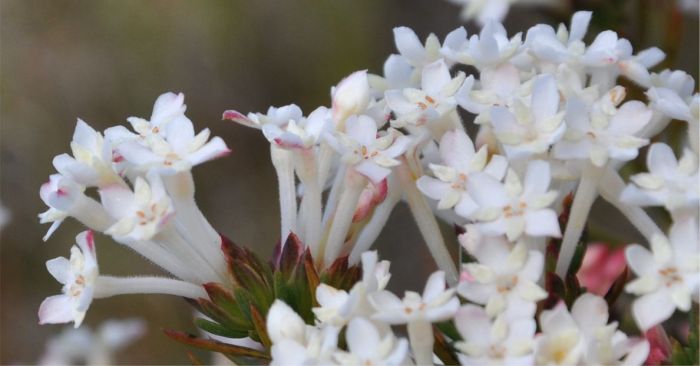
Conservation Status
Status
According to Raimondo et al. (2009), Gnidia pinifolia has an automated status of Least Concern (LC) from the four screening processes for highlighting potential taxa of conservation concern. This is not a species of conservation concern, it has a stable wild population although in some areas its population clusters are small.

Distribution and habitat
Distribution description
Gnidia pinifolia is endemic in South Africa, it grows on flats and lower to middle slopes from Piketberg in the Western Cape to the Eastern Cape. In the Western Cape, it occurs widely on the Cape Peninsula, and the type specimen was collected on the mountain slopes above Clovelly.

Derivation of name and historical aspects
History
The genus, Gnidia was possibly named after the classical Greek city Cnidus, currently known as Cumali. A.S. Hitchcock and M.L. Green selected G. pinifolia L. as the type of the generic name in 1929. Gnidia pinifolia was first described by Linnaeus in 1782 in Supplementum Plantarum, and his son, Linnaeus filius, further elaborated on his father’s work, using more complete material that Linnaeus had received from Anders Sparrman (1748–1820) in about 1772 and identified it as belonging to that species. However, the material that Linnaeus filius used applies to G. simplex L.
The species name pinifolia, means ‘leaves like a pine (genus Pinus)’, referring to its needle-like leaves that resemble pine needles.
The common name juffertjie-roer-by-die-nag means ‘young-lady-gad-about-at-night’ and refers to the strong, sweet scent emitted by the flowers during the evening and at night, which hangs in the evening air and the scent reminds one of perfumed young ladies out for a night in the town.
According to Bhandurge et al (2013) Gnidia is the renowned largest genus in the sub-cosmopolitan family, Thymelaeaceae.
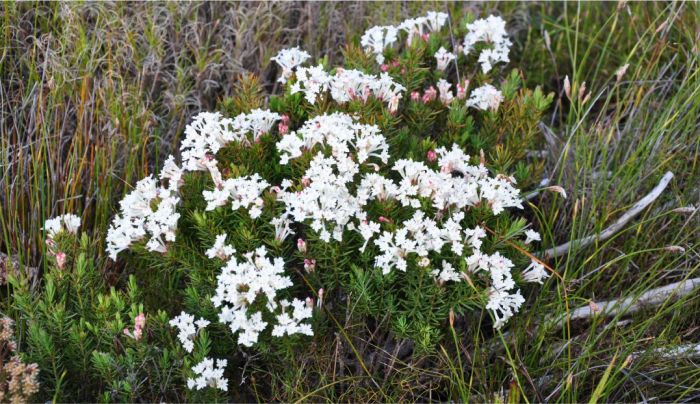
Ecology
Ecology
The sweet-scented night fragrance that the flowers of Gnidia pinifolia emit, attract insect pollinators like night-flying moths. This species is adapted to the cool and rainy winter and hot and dry summer seasons of the Western Cape. Transpiration is reduced through its leaves thanks to their small surface area.
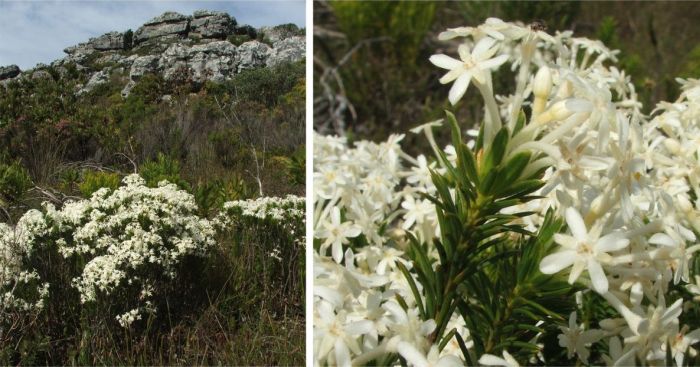
Uses
Use
Although Gnidia pinifolia is not known to have any medicinal or traditional uses, this genus and its sister genus Lasiosiphon, have immense pharmacological potential because many species contain huge amounts of useful daphnane orthoesters that have remarkable biological activities. Some species have both medicinal and commercial significance, however, large-scale cultivation for commercial purposes has not yet been undertaken. According to Notten (2004) many species are used to make ties used for bundles of wood, thatching and clothing and Van-Wyk & Gericke (2000) added that flowers of various species of Gnidia are used for dyeing leather. According to Bhandurge et al (2013), some species of Gnidia have been employed as traditional treatments for a wide range of human and animal medical issues, including constipation, pulmonary tuberculosis, bruises and burns, stabilization of heart conditions, backaches, toothaches, as well as conception and childbirth, stomach, and chest concerns. Moreover, antileukemic properties have been recorded from some Gnidia extracts. In some countries, ailments and complaints in livestock, such as anthrax and botulism, were cured using leaf parts of some species of Gnidia. Severe irritant effects as well as death has been reported in humans and animals due to high levels of toxic coumarins and diterpene esters produced by some Gnidia plants that are used in traditional medicine.
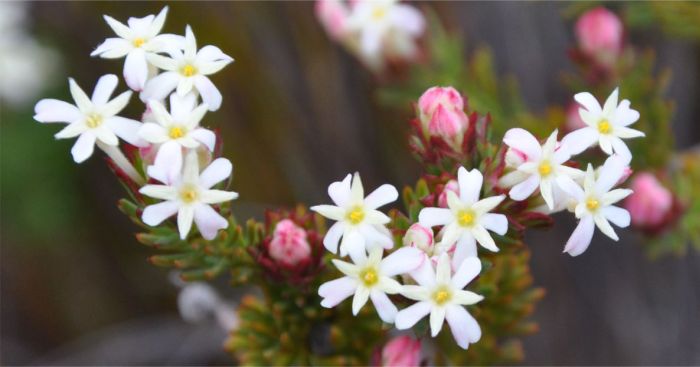
Growing Gnidia pinifolia
Grow
Based on available information, it is best to propagate this genus using cuttings. Stem, heel, and tip cuttings are used to propagate this semi-hardwood plant. To produce healthy and vigorous plants, root stimulating hormones are used. Cuttings are taken during the cool season; this is to reduce transpiration. A well-drained rooting mixture of silica grit, perlite, or polystyrene is used, with sufficient water. Ensure a moderately humid mist house and place the cuttings on heated benches for optimal rooting. Some cuttings will produce roots in 5 to 6 weeks and they will need to be transferred into slightly bigger pots. Rooted cuttings can then be transplanted into larger containers once fully established, with adequate watering until well grown. At about 4 to 5 weeks, plants can be planted out into the garden.
This fragrant shrub flowers all-year-round, from January to December. Gnidia pinifolia does well in full sun and well-drained soil and is ideal for sunny fynbos gardens. In the wild, it grows in fynbos vegetation and where the author has spotted this plant species, no signs of pest or diseases were detected.
References
- Bhandurge, P., Rajarajeshwari, N., Ganapaty, S. & Pattanshetti, S. 2013. The Gnidia genus: A review. Asian Journal of Biomedical and Pharmaceutical Sciences 3: 1–31.
- Gabayi, M. 2015. Gnidia denudata Lindl. (Thymelaeaceae). PlantZAfrica. Online. http://pza.sanbi.org/gnidia-denudata
- Goldblatt, P. & Manning, J. 2002. Cape plants: a conspectus of the Cape flora of South Africa. Strelitzia 9. National Botanical Institute, Pretoria and Missouri Botanical Garden, St Louis.
- Notten, A. 2004. Gnidia squarrosa (L.) Druce. (Thymelaeaceae). PlantZAfrica. Online. http://pza.sanbi.org/gnidia-squarrosa.
- Raimondo, D., Von Staden, L., Foden, W., Victor, J.E., Helme, N.A., Turner, R.C., Kamundi, D.A. & Manyama, P.A. (eds) 2009. Red list of South African plants. Strelitzia 25. South African National Biodiversity Institute, Pretoria.
- Rogers, Z.S. & Spencer, M.A. 2006. Typification of plant names in Thymelaeaceae published by Linnaeus and Linnaeus filius. TAXON 55(2): 483–488.
- Van Wyk, B.-E. & Gericke, N. 2000. People's plants, a guide to useful plants of southern Africa. Briza Publications, Pretoria.
- Wright, C.H. 1925. Gnidia pinifolia Linn. in Flora capensis Vol 5, Part 2. Accessed via JSTOR Global Plants. https://plants.jstor.org/compilation/gnidia.pinifolia.
Credits
Nomfusi Ntsobi
Custodians of Rare & Endangered Wildflowers (CREW)
February 2022
Acknowledgements: images by Alice Notten
Plant Attributes:
Plant Type: Shrub
SA Distribution: Eastern Cape, Western Cape
Soil type: Sandy
Flowering season: Sporadic/All year
PH: Acid
Flower colour: White, Pink
Aspect: Full Sun
Gardening skill: Average
Special Features:
Horticultural zones







Rate this article
Article well written and informative
Rate this plant
Is this an interesting plant?
Login to add your Comment
Back to topNot registered yet? Click here to register.